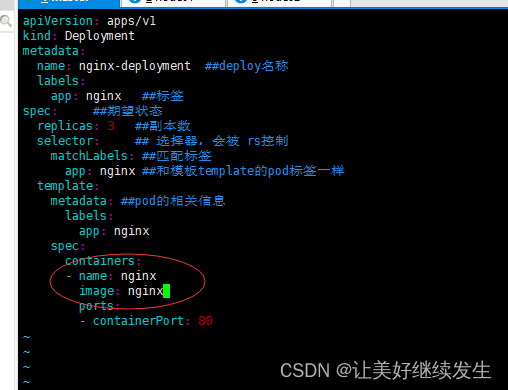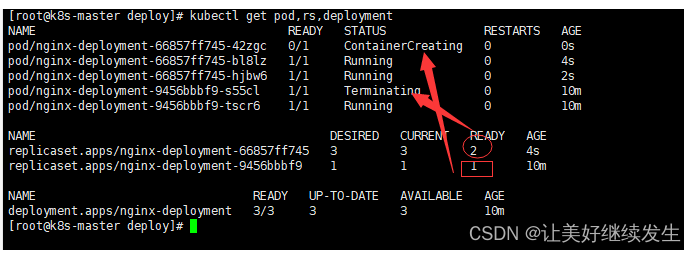k8s之deployments相关操作
介绍
官网是这样说明如下:
一个 Deployment 为 Pod 和 ReplicaSet 提供声明式的更新能力。
你负责描述 Deployment 中的目标状态 ,而 Deployment 控制器(Controller) 以受控速率更改实际状态, 使其变为期望状态。你可以定义 Deployment 以创建新的 ReplicaSet,或删除现有 Deployment, 并通过新的 Deployment 收养其资源。
deployment创建
使用 kubectl explain deploy 解释一下 deployment,如下所示
bash
[root@k8s-master deploy]# kubectl explain deploy
KIND: Deployment
VERSION: apps/v1
DESCRIPTION:
Deployment enables declarative updates for Pods and ReplicaSets.
FIELDS:
apiVersion <string>
APIVersion defines the versioned schema of this representation of an
object. Servers should convert recognized schemas to the latest internal
value, and may reject unrecognized values. More info:
https://git.k8s.io/community/contributors/devel/sig-architecture/api-conventions.md#resources
kind <string>
Kind is a string value representing the REST resource this object
represents. Servers may infer this from the endpoint the client submits
requests to. Cannot be updated. In CamelCase. More info:
https://git.k8s.io/community/contributors/devel/sig-architecture/api-conventions.md#types-kinds
metadata <Object>
Standard object's metadata. More info:
https://git.k8s.io/community/contributors/devel/sig-architecture/api-conventions.md#metadata
spec <Object>
Specification of the desired behavior of the Deployment.
status <Object>
Most recently observed status of the Deployment.官网给的示例文件如下:其中创建了一个 ReplicaSet,负责启动三个 nginx Pod
bash
apiVersion: apps/v1
kind: Deployment
metadata:
name: nginx-deployment ##deploy名称
labels:
app: nginx ##标签
spec: ##期望状态
replicas: 3 ##副本数
selector: ## 选择器,会被 rs控制
matchLabels: ##匹配标签
app: nginx ##和模板template的pod标签一样
template:
metadata: ##pod的相关信息
labels:
app: nginx
spec:
containers:
- name: nginx
image: nginx:1.14.2
ports:
- containerPort: 80将官网给的示例创建一个yaml文件运行,然后使用 kubectl get pod,rs,deployment 查看效果如下所示
bash
[root@k8s-master deploy]# kubectl get pod,rs,deployment
NAME READY STATUS RESTARTS AGE
pod/nginx-deployment-9456bbbf9-k4r99 1/1 Running 0 76s
pod/nginx-deployment-9456bbbf9-s55cl 1/1 Running 0 76s
pod/nginx-deployment-9456bbbf9-tscr6 1/1 Running 0 76s
NAME DESIRED CURRENT READY AGE
replicaset.apps/nginx-deployment-9456bbbf9 3 3 3 76s
NAME READY UP-TO-DATE AVAILABLE AGE
deployment.apps/nginx-deployment 3/3 3 3 76s可以看到一个deploy 最终产生三个资源。其中 rs控制者pod副本数量,deploy控制rs
deployment更新
上面的部署nginx的版本使用的是nginx:1.14.2,现在想要使用最新的版本,只需要编辑yaml中信息即可

然后 使用 kubectl get pod,rs,deployment 查看

可以查看到它并不是把所有的pod都杀掉,而是杀掉一个,然后在启动一个,这个就是滚动更新
可以看到一次升级会产生一个rs,最终也是通过rs 来进行回滚

最终都升级好以后可以看到最新的rs状态

使用 kubectl rollout history deployment.apps/nginx-deployment查看deploy历史

可以看到有两次变动,如果想要回到上一个版本,可以使用 kubectl rollout undo deployment.apps/nginx-deployment --to-revision=1 进行回滚

比例缩放
使用 kubectl explain deploy.spec 解释一下 spec中的字段
bash
[root@k8s-master deploy]# kubectl explain deploy.spec
KIND: Deployment
VERSION: apps/v1
RESOURCE: spec <Object>
DESCRIPTION:
Specification of the desired behavior of the Deployment.
DeploymentSpec is the specification of the desired behavior of the
Deployment.
FIELDS:
minReadySeconds <integer> //认定read状态以后,多久杀死旧的pod
Minimum number of seconds for which a newly created pod should be ready
without any of its container crashing, for it to be considered available.
Defaults to 0 (pod will be considered available as soon as it is ready)
paused <boolean> //是否停止暂停更新
Indicates that the deployment is paused.
progressDeadlineSeconds <integer> //处理的最终期限
The maximum time in seconds for a deployment to make progress before it is
considered to be failed. The deployment controller will continue to process
failed deployments and a condition with a ProgressDeadlineExceeded reason
will be surfaced in the deployment status. Note that progress will not be
estimated during the time a deployment is paused. Defaults to 600s.
replicas <integer> //pod副本数量
Number of desired pods. This is a pointer to distinguish between explicit
zero and not specified. Defaults to 1.
revisionHistoryLimit <integer> //旧副本集保留的数量
The number of old ReplicaSets to retain to allow rollback. This is a
pointer to distinguish between explicit zero and not specified. Defaults to
10.
selector <Object> -required-
Label selector for pods. Existing ReplicaSets whose pods are selected by
this will be the ones affected by this deployment. It must match the pod
template's labels.
strategy <Object> //新pod 替换的策略
The deployment strategy to use to replace existing pods with new ones.
template <Object> -required-
Template describes the pods that will be created.所以 比例缩放也就是围绕 strategy 字段来展开的
使用 kubectl explain deploy.spec.strategy 解释一下 strategy
bash
[root@k8s-master deploy]# kubectl explain deploy.spec.strategy
KIND: Deployment
VERSION: apps/v1
RESOURCE: strategy <Object>
DESCRIPTION:
The deployment strategy to use to replace existing pods with new ones.
DeploymentStrategy describes how to replace existing pods with new ones.
FIELDS:
rollingUpdate <Object>
Rolling update config params. Present only if DeploymentStrategyType =
RollingUpdate.
type <string>
Type of deployment. Can be "Recreate" or "RollingUpdate". Default is
RollingUpdate.然后在使用 kubectl explain deploy.spec.strategy.rollingUpdate 解释一下rollingUpdate
bash
[root@k8s-master deploy]# kubectl explain deploy.spec.strategy.rollingUpdate
KIND: Deployment
VERSION: apps/v1
RESOURCE: rollingUpdate <Object>
DESCRIPTION:
Rolling update config params. Present only if DeploymentStrategyType =
RollingUpdate.
Spec to control the desired behavior of rolling update.
FIELDS:
maxSurge <string> //一次最多创建几个 pod, 可以是百分比也可以是数字
The maximum number of pods that can be scheduled above the desired number
of pods. Value can be an absolute number (ex: 5) or a percentage of desired
pods (ex: 10%). This can not be 0 if MaxUnavailable is 0. Absolute number
is calculated from percentage by rounding up. Defaults to 25%. Example:
when this is set to 30%, the new ReplicaSet can be scaled up immediately
when the rolling update starts, such that the total number of old and new
pods do not exceed 130% of desired pods. Once old pods have been killed,
new ReplicaSet can be scaled up further, ensuring that total number of pods
running at any time during the update is at most 130% of desired pods.
maxUnavailable <string> //最大不可用数量
The maximum number of pods that can be unavailable during the update. Value
can be an absolute number (ex: 5) or a percentage of desired pods (ex:
10%). Absolute number is calculated from percentage by rounding down. This
can not be 0 if MaxSurge is 0. Defaults to 25%. Example: when this is set
to 30%, the old ReplicaSet can be scaled down to 70% of desired pods
immediately when the rolling update starts. Once new pods are ready, old
ReplicaSet can be scaled down further, followed by scaling up the new
ReplicaSet, ensuring that the total number of pods available at all times
during the update is at least 70% of desired pods.最终示例如下
bash
apiVersion: apps/v1
kind: Deployment
metadata:
name: nginx-deployment ##deploy名称
labels:
app: nginx ##标签
spec: ##期望状态
revisionHistoryLimit: 10 ##保留最近的副本数量
progressDeadlineSeconds: 300
paused: false ##暂停更新
replicas: 7 ##副本数
strategy:
# type: Recreate #不推荐
rollingUpdate:
maxSurge: 20%
maxUnavailable: 2
selector: ## 选择器,会被 rs控制
matchLabels: ##匹配标签
app: nginx ##和模板template的pod标签一样
template:
metadata: ##pod的相关信息
labels:
app: nginx
spec:
containers:
- name: nginx
image: nginx:stable-alpine3.19-perl
ports:
- containerPort: 80然后运行 kubectl get pod,rs,deploy 进行观察